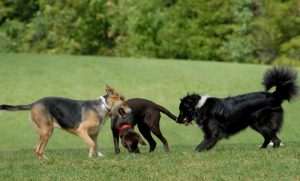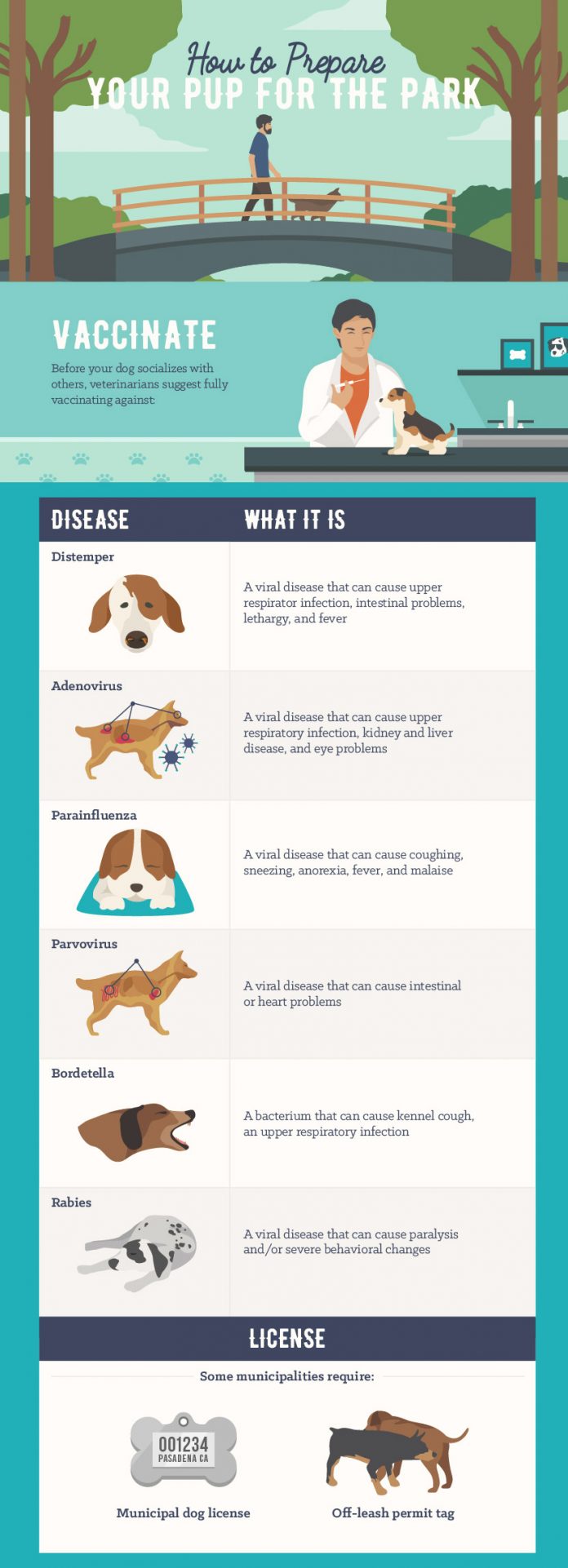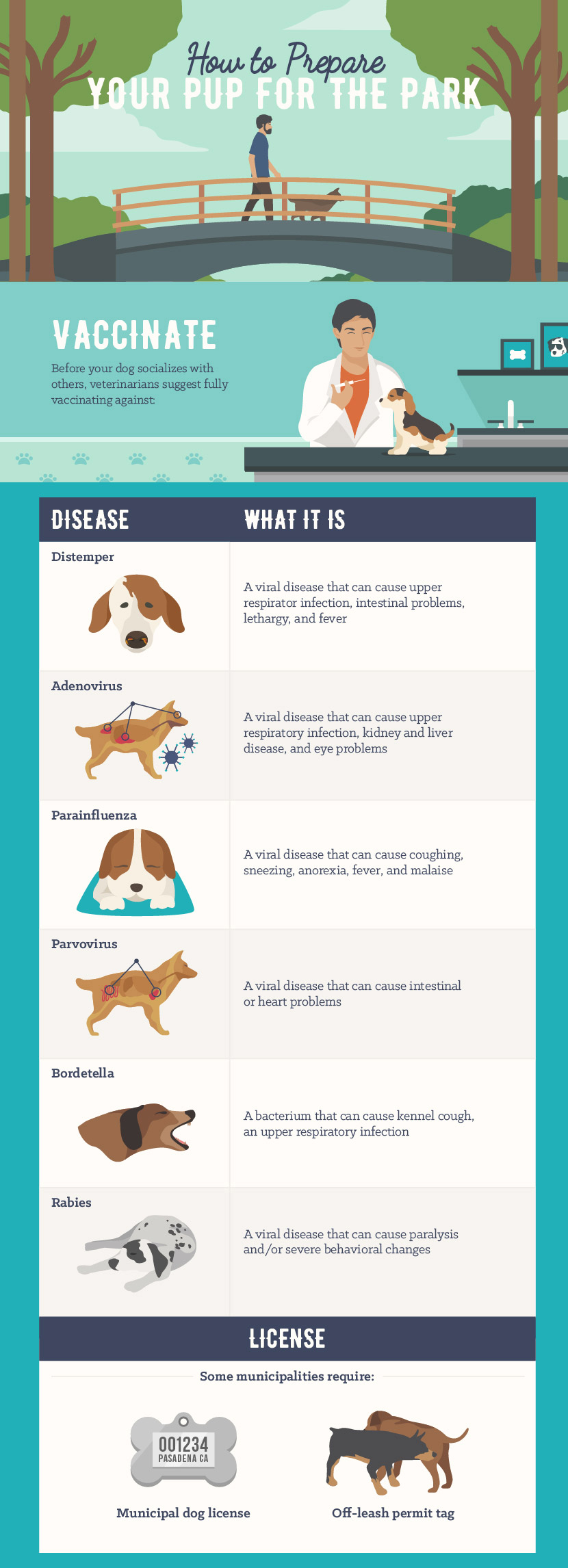 Many of our parks are going to the dogs – literally. There are already about 1,200 off-leash dog parks in the United States. That number is growing rapidly, with an increase of 20 percent between 2010 and 2015 alone.12
Many of our parks are going to the dogs – literally. There are already about 1,200 off-leash dog parks in the United States. That number is growing rapidly, with an increase of 20 percent between 2010 and 2015 alone.12
It’s no wonder. Nearly 57 million American households include a canine family member, and dog parks are a great place to let pooches play, run unleashed, and socialize.3 Many dogs love dog parks. What better spot for people to meet like-minded dog lovers and do a little dog watching?
However, a visit to the dog park can be a daunting experience for a newcomer. It can feel like entering a foreign country, with confusing rituals and an undecipherable language. While there are some potential hazards at dog parks, you can avoid many risks by knowing when and how to introduce your dog, learning a little about canine relationships and body language, and being aware of park etiquette and safety measures.
Read on for guidance to help you and your pooch have fun at the park.
Introducing Puppy to the Park
You can set your new puppy up for success by mindfully introducing her to the park. Try these best practices:
- Make your first visit when your pup is between four and six months old, after she’s had all of her vaccinations and when she consistently comes when she’s called.
- Go during off-peak hours the first several times. Parks are usually busiest after work on weekdays and on Saturdays. Try early in the morning, mid-day, or late in the evening on a weekday.
- Take your pup for a walk first to help her burn off some energy.
- Survey the park before entering. Look for dogs who exhibit aggressive body language. Come back on a different day if you’re concerned about any of the dogs.
- If possible, enter through a quiet side entrance. That way your pup won’t feel ganged up on by dogs the minute you enter.
- Once you’re inside, walk around the park instead of standing in one place to keep your puppy from feeling stuck in a group or unpleasant situation.
- Look for dogs of similar age and size for your puppy to play with.45
Recognizing Friendly Dog Play
Humans mostly use words to communicate, and dogs mostly use body language and scent. That’s probably why canine relationships can feel foreign to many of us. Fortunately, dog trainers and experts are around to help decode canine greetings, body language, and communication. Off Leash Dog Play: A Complete Guide to Safety and Fun by Robin Bennett and Susan Briggs is an excellent resource to help owners recognize when dogs are having fun at the dog park or when it may be best to intervene or leave.
Friendly canine play can look aggressive because dogs “play fight” with each other. That means they may chase and tackle each other, bite at each other’s necks, slam into each other, and even bark, snarl, and growl at each other. But you can differentiate between play fighting and real fighting by watching the canines’ body language and looking for signs of friendly play.6
Spotting Warning Signs
Of course, dog interactions are not always friendly. It’s important to recognize when a dog, whether it’s yours or someone else’s, is being aggressive. (This probably goes without saying, but if your dog has been aggressive toward other dogs, it’s best to stay away from dog parks and find other places and ways to play.) If your dog has ever shown aggressive, possessive behavior over balls or treats at home, leave those items back at the house and keep a wide distance from owners who bring them to the park.
If your dog shows signs of anxiety or fear, it may be time to move to a new area of the park or leave for the day. If you can’t tell whether your dog is enjoying a bout of play or not, try removing him from the situation for a minute. If he presses his body into yours and avoids looking at the other dog or dogs, he probably wants to leave. If he pulls against your grip and looks toward the other dog or dogs, he probably wants to stay.7
Preventing Common Parasites and Illnesses
There are a few common illnesses and parasites your dog can get at the dog park. Fortunately, they can all be prevented.
- Giardia and Cryptosporidium
These two microscopic intestinal parasites, which cause diarrhea and abdominal discomfort, are common at dog parks. They’re spread through contaminated fecal material.8 To prevent your dog from getting them, remember to do the following:
- Discourage drinking from dirty ponds and puddles.
- Consider bringing your own water bowl and avoid shared drinking areas.
- Bathe your dog if you suspect he may be soiled with fecal matter; do not let him lick himself clean.9
- Fleas and Ticks
Depending on where you live, these parasites may be a year-round concern. Veterinarians recommend regularly treating pets with topical or internal flea-and-tick products to keep pests at bay.10
- Heat stroke
Dogs can’t cool themselves by sweating the way we do, so it’s important to make sure they don’t get too hot. To help with this, try some of these tips:
- In the summer, avoid the park at mid-day, when it’s hottest out.
- Take breaks to let your dog drink water and sit in the shade.
- If your dog pants excessively or seems delirious, take measures to cool her immediately by providing drinking water and spraying her with or immersing her in cold water.
- If your dog collapses, vomits, or exhibits other worrying signs while playing in the heat, contact your vet immediately.11
Conclusion
Dogs, like people, are all different. Some of them don’t care for the dog park. If your pup consistently shows signs of stress or indifference at the park, it may not be his thing. Don’t worry; there are lots of ways to keep a dog happy and healthy. Try some of these alternatives to the dog park:
- Go for plenty of walks.
- Play together in a large backyard.
- Scout out some semi-enclosed park or open space where your dog can safely run and play fetch.
- Invite one or two friendly dogs over to play with yours.
- Build a DIY canine agility course with obstacles, jumps, and tunnels.1213
Of course, there’s another possibility: Your pooch may not want to go anywhere but the dog park. With space to run and friends to play with, the dog park is many dogs’ dream come true. With a little knowledge, it can be a lot of fun for humans too.
Sources:
- http://www.parksandrecreation.org/2015/May/The-Truth-About-Parks-and-Dogs/
- http://www.tpl.org/media-room/dog-parks-lead-growth-us-city-parks
- http://www.parksandrecreation.org/2015/May/The-Truth-About-Parks-and-Dogs/
- http://dogtime.com/dog-health/general/5014-introduce-puppy-dog-parks-dunbar-faq
- http://www.quickanddirtytips.com/pets/dog-behavior/should-you-take-your-dog-to-dog-parks-and-dog-runs
- http://thebark.com/content/your-dogs-rough-play-appropriate
- http://thebark.com/content/your-dogs-rough-play-appropriate
- http://www.ncbi.nlm.nih.gov/pubmed/21890275
- http://www.petmd.com/blogs/fullyvetted/2012/june/parasites_dog_parks-25039
- https://www.cesarsway.com/dog-care/flea-and-tick/how-to-protect-your-dog-against-fleas-and-ticks
- http://www.premiumedgepetfood.com/vet-notes/dog-park-dangers/
- http://www.dogster.com/lifestyle/when-theres-no-dog-park
- http://www.thisoldhouse.com/toh/how-to/intro/0,,20296555,00.html
















 GIF.gif)




